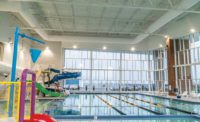An onslaught of natatorium retrofits are coming, as a large wave of dehumidifiers reaches the end of its collective lifecycle. Limited mechanical space, unique IAQ concerns, and an evolving refrigerant landscape only cloud the design waters further. Reflect on this Ottawa suburb’s retrofit to get a glimpse of the tasks and technologies waiting for engineers beneath the surface of tomorrow’s pool projects.
The newly refurbished Kanata Leisure & Fitness Centre Wave Pool (KLFCWP) in Kanata, Ontario, gives HVAC engineers and contractors an unprecedented look into the challenges they’ll face in future natatorium retrofits.
These retrofits will undoubtedly challenge North American engineers in the next 10 years as thousands of DX dehumidifiers from the hey-day of the 1980s and 1990s natatorium construction era end their useful lifecycles. The 28-year-old KLFCWP can serve as a retrofit role model for these pending natatorium retrofits because it’s using tomorrow’s technology today. For example, KLFCWP is using a reduced refrigerant DX dehumidification system, advanced technology fans, glycol and dry coolers for heat rejection, exhaust heat recovery, and other state-of-the-art equipment. Most importantly, daily web-based monitoring and control from factory technicians promise to maintain the same optimum efficiency as the day the units were started up.
Some future natatorium retrofits also pose seemingly insurmountable obstacles not typically covered in mechanical engineering textbooks, such as fitting dehumidifiers the size of sea containers into mechanical rooms originally designed without access or space for replacement equipment.
Thanks to its consulting engineering firm Goodkey Weedmark & Associates Ltd., in Ottawa, Ontario, the Kanata parks and recreation program’s crown jewel facility was successfully restored into an aquatic paradise of IAQ that features a wave pool, children’s pool, water slide, and spa. Meeting the $500,000 recreation center’s engineering challenge was Goodkey Weedmark’s Steven Hamilton, P.E.; Andre Bogdanowicz, P.E.; and mechanical contractor T.P. Crawford. The team designed an HVAC system retrofit solution that not only provided unprecedented indoor air comfort and fit into a cramped mechanical room, but it also lessened the city’s environmental impact with many energy efficiency options and reduced refrigerant.
Phychrometrics
The original system, consisting of two mechanical dehumidifiers and an air handler, never fully attained an optimal IAQ, according to Hamilton. Therefore, engineers didn’t specify just a drop-in replacement system with similar moisture-removing capabilities. Instead, the design team performed psychrometrics calculations to reevaluate humidity load capacity. The water agitation and resulting increased evaporative rate from a two-story water slide, spray fountains, a 24- by 10-ft 100°F whirlpool spa, and a 131- by 43-ft wave pool required a moisture removal capacity of 500 lbs/hr, which far surpasses humidity loads generated by conventional natatoriums. The Ottawa branch of manufacturer’s representative, HTS HVAC Services, assisted Goodkey Weedmark in developing the project’s evaporative rate calculations and sizing of a “Protocol” NP-Series, 80-ton dehumidifier custom-manufactured by Seresco Technologies.
Goodkey Weedmark’s specification of one large 8.5- by 10- by 24-ft pool dehumidification unit saved KLFCWP tens of thousands of dollars in rigging costs, installation labor, and facility downtime. Goodkey Weedmark, which has engineered more than a dozen indoor pools including several YMCA projects, also specified the dehumidifier for space air conditioning, which wasn’t included in the facility’s original design. Air conditioning is actually a bit of a misnomer — this option actually allows the unit to operate normally year round without the space overheating. Without a means to reject excess heat outdoors during warm weather, the space will eventually get too warm for a system to operate. The addition of the remote air cooled dry cooler allows the system to reject excess heat outdoors as needed and maintains the space conditions year-round.
Hamilton saved the project additional money by reusing the existing ductwork and distributing the air more efficiently with directional supply grilles by Metalaire.
Reducing Refrigerant is the Future
Reducing the city’s refrigerant dependence was another accomplishment in the HVAC design. Seresco’s Protocol dehumidifier, which was named after the 1997 Kyoto Protocol environmental treaty, is designed to use 75% less refrigerant than a conventional DX dehumidifier, except without a performance loss. Instead, the system uses 35 gallons of non-toxic propylene glycol and a heat exchanger for heat rejection to outdoor dry coolers and supplants nearly 700 lbs of refrigerants. The Protocol does have a 25% refrigerant charge of 160 lbs, but it’s self-contained within the refrigeration circuit and is less susceptible to leaks because it is factory-sealed, charged, and tested.
“We see a definite trend toward reduced refrigerant HVAC systems from all types of manufacturers because piping glycol to dry coolers for heat rejection makes much more sense than investing in hundreds of pounds of costly refrigerant that pose a liability potential of leaks and environmental damage for a facility,” said Ralph Kittler, P.E., vice president of Seresco USA, who recently wrote the Natatorium Design Guide, a free publication that prepares engineers for all aspects of indoor pool design and specification.
Incorporating glycol allowed the facility to use a technology more environmentally friendly than in all-refrigerant systems, while also avoiding the occasional joint or coil leaks possible in a system with long field-installed runs and outdoor condensers. Additionally, the expected price rise during R-410A’s anticipated future phase-out with other “super greenhouse effect” hydrofluorocarbon (HFC) refrigerants will have less of an effect on Kanata’s maintenance costs throughout the dehumidifier’s lifecycle.
Goodkey Weedmark’s green specification for reducing refrigerants doesn’t decrease performance. Reduced-refrigerant dehumidifiers potentially are equally efficient as conventional DX systems on summer design days and 5% to 7% more efficient throughout the rest of the year.
Besides saving more than $10,000 in R-410A costs, the reduced-refrigerant design also saved the city tens of thousands of dollars in labor and materials on the project because glycol uses less expensive and quicker-installing PVC piping instead of copper. Refrigerants require government-certified installers, labor-intensive soldering, and copper piping, which is susceptible to black market theft for the scrap metal value. Glycol is less than $2/lb versus R-410A refrigerant which is $12 to $15/lbs.
Energy Efficiency
Besides the reduced refrigerant savings, Goodkey Weedmark also specified several dehumidifier options that will save tens of thousands of dollars in operational costs over the equipment’s lifecycle:
- Heat recovery from the refrigeration circuit waste heat is used to supply the majority of pool water heating.
- Exhaust air heat recovery pre-heats outdoor air.
- Direct drive fans save up to 20% more energy versus their conventional belt-driven counterparts.
- The dehumidifier also performs space heating/cooling as well as dehumidification.
These energy-efficiency functions, plus dozens of dehumidifier-operation parameters, promise optimal performance throughout the equipment’s lifecycle thanks to WebSentry, a web browser-based software/hardware application that’s offered free on all Seresco commercial dehumidifiers. Each unit’s Ethernet connection allows 24/7 real-time data transmission and extranet access for facility managers, service contractors, and factory technicians via computers and smartphones.
“The many options offered by dehumidifier manufacturers today are investments that require higher upfront capital equipment costs versus a bare-bones model that just dehumidifies. However, city officials are committed to increasing facility sustainability and saving hundreds of thousands of dollars in total energy costs in the long term on retrofit projects,” said Hamilton.
Goodkey Weedmark also upgraded the pool water circulation system performance with a 5-hp pump and 857-kWh heat exchanger, both manufactured by Bell & Gossett.
Correcting IAQ Issues
Goodkey Weedmark addressed KLFCWP’s previous IAQ issues by increasing the supply air volume by 20% and adding more air changes. ASHRAE recommends four to six volumetric ACH in conventional natatoriums and six to eight volumetric changes in spectator areas. The new dehumidifier was also specified with a fan/exhaust airflow option that expedites a purge of all indoor air in only eight minutes after periodical water chemistry shock treatments (or during excessive chloramines or CO2 levels during heavily attended spectator events).
KLFCWP never experienced chloramines issues, but many pools in North America have lodged complaints of “lifeguard lung,” a respiratory issue caused by excessive chloramines. For example, the 2007 Olympic swimming trials in Indiana were momentarily stopped because swimmers had breathing difficulties from excessive chloramines. The heavy, toxic gas is a byproduct of free chlorine combining with organics in the pool water, such as ammonia, urine, and perspiration. When free chlorine is insufficient, organics aren’t oxidized and chloramines will form. The newly-formed substance then stratifies and off-gasses above the water surface, which unfortunately for swimmers represents their breathing zone. So every breath during swimming can introduce a heavy dose of chloramines to the lungs.
Mechanical Room Knock-Down and Assembly
Although the center needed more HVAC capacity, the mechanical room was already cramped. The KLFCWP’s absence of shipping door access or adjacent space for expansion created a logistics challenge for the project’s engineer and mechanical contractor. Upon site inspection, Goodkey Weedmark engineers saw the facility’s mezzanine level outdoor air louver as a possible mechanical room access point for rigging the unit. Goodkey Weedmark worked with Seresco to have the unit factory-bolted instead of welded together, and then knocked down into three 8-ft-long sections after it was assembled and tested at the factory.
Contractor T.P. Crawford’s main job challenge was enlarging the louver hole to 9.1 by 9.8 ft (2.8 x 3 meters) for easier access. The three 8-ft-long sections were rigged through the louver opening, then T.P. Crawford assembled and installed it inside the mechanical room. The louver opening was opened and then refitted with a new outdoor air damper/louver by Ventex. The enlarged access was also beneficial for complying with ASHRAE Standard-62 outdoor air rates that have increased since the original building’s construction in 1986.
Mechanical rooms with no access will continue to challenge engineers as more dehumidifiers installed between 1980 and 2000 will require retrofitting. Luckily, there are a many solutions for inaccessible or cramped mechanical rooms and each one has its own advantages as related to the given site conditions and retrofit budgets.
- Remove door and bricks as needed around access door openings to accommodate the replacement unit.
- Have a replacement unit custom-built to fit through available access doors.
- Open the roof to gain access to the mechanical room.
- Knock-down the unit into small sections and assemble as a complete unit inside the mechanical room.
- Gut the unit and assemble new components into the original dehumidifier’s shell.
- Use several smaller modular units designed to fit through 32-in doors and combine for the capacity of the original large unit(s).
The modular unit is one technological advancement that can help ease tight or inaccessible mechanical rooms needing more HVAC capacity in a retrofit. Manufacturers have recently developed these smaller modular units that fit through 32-in doorways. They are smaller in capacity, but they can be stacked in pairs that can add up to one larger unit’s capacity. Each has a compressor, supply air fans, etc.; however, they can operate together or independently in staged operation, which can offer valuable energy and redundancy benefits when combined with microprocessor controllers.
The Niles Family Fitness Center in Niles, IL, a $14 million, 100,000-sq-ft facility when it was built in the 1990s, recently chose modular units for its retrofit. Its original dehumidifier was fairly large and controlled 290 lbs of moisture per hour in the 8,000-sq-ft natatorium wing’s 4,500-sq-ft pool. The consulting engineer opted to stack smaller dehumidifiers designed specifically for modular applications.
Another option is to gut the original unit and install new compressor, coil, and fan components into the existing shell, such as a recent retrofit at Stevenson High School in Lincolnshire, IL, which is a premier eight-lane, 50-meter pool with a 1,000-seat spectator section that’s used for many Illinois High School Association state swim meets. The retrofit contractor was challenged with the size of the dehumidifier and its replacement, so the team chose to use the existing shell and build energy-efficient components into it.
If the KLFCWP is any indication of what lies in store for consulting engineers, navigating difficult mechanical room logistics and choosing options that will keep the facility state-of-the-art 25 years from now will be their primary challenge in future natatorium retrofits.







